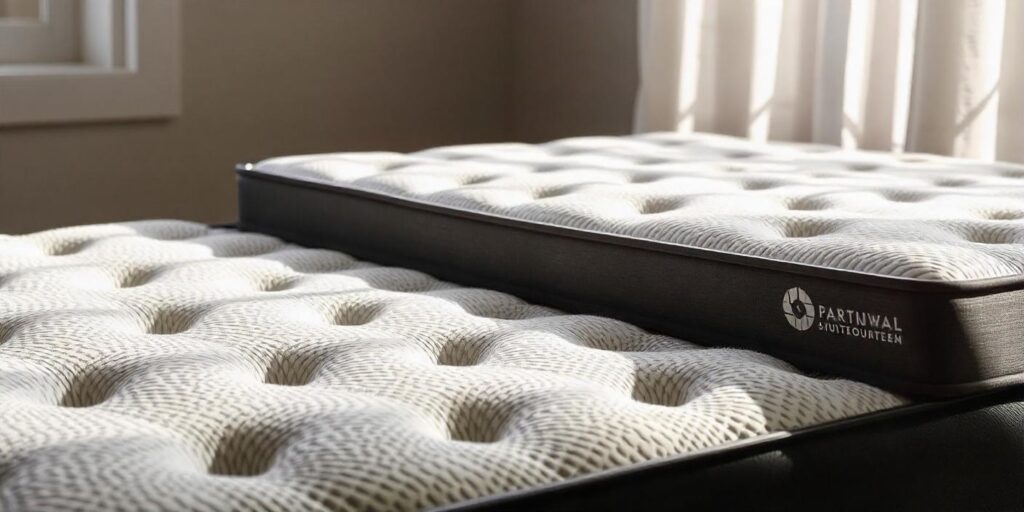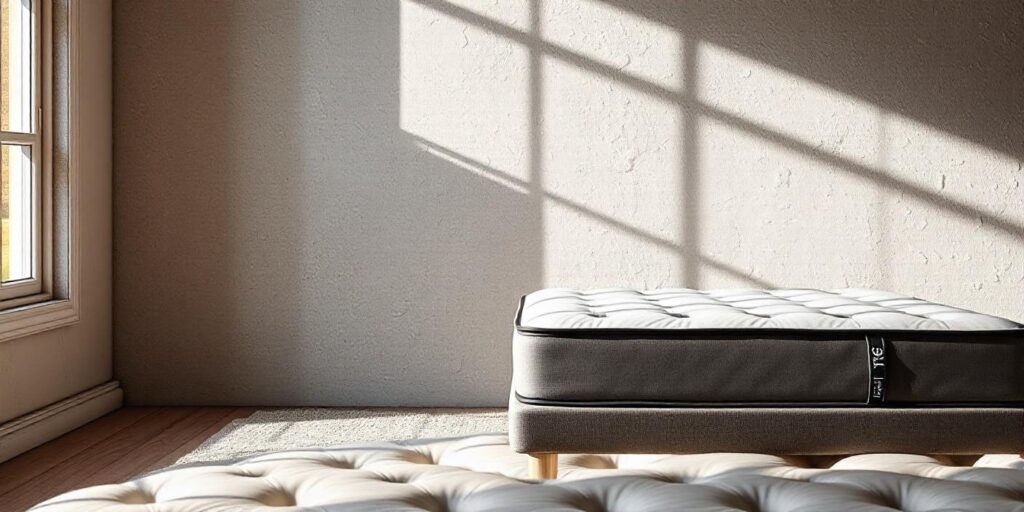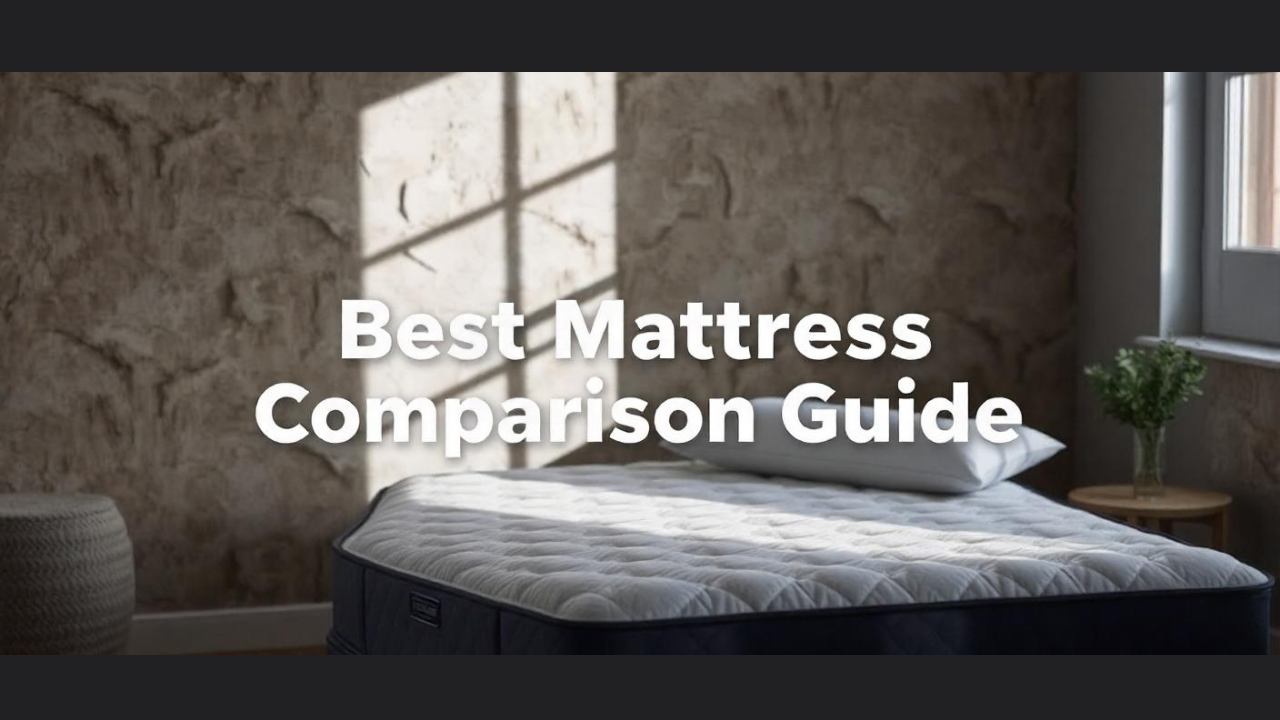Welcome to the ultimate Best Mattress Comparison Guide. Choosing the perfect mattress isn’t just about finding one that looks good—it’s about discovering the ideal fit for your sleep style, comfort preferences, and health needs. With countless options available, from memory foam to hybrid mattresses, it’s easy to feel overwhelmed. But don’t worry, I’ve got you covered.
In this comprehensive guide, I compare the top mattresses on the market, helping you navigate through the noise to find the best mattress that suits your needs. Whether you’re after a budget-friendly option, seeking the best cooling mattress for hot sleepers, or needing the best mattress for back pain, this guide will provide all the insights you need. Stick around, and let’s find the best mattress for you together.
For the best mattress, consider the following top options: memory foam for contouring support, innerspring for traditional bounce, and hybrid for a balance of both. Each type caters to different sleep preferences and body types. Evaluate your personal needs and preferences to make the best choice.
Sleep is a vital component of our daily lives, and the mattress you choose is crucial in ensuring you get a restful and rejuvenating night’s sleep. With the vast array of mattress types, materials, and brands available today, finding the perfect mattress can be overwhelming. This guide aims to simplify your decision-making process by providing detailed information and comparisons of the most popular mattress types.
Types of Mattresses
Memory Foam Mattresses
Features
Memory foam mattresses are known for their contouring ability, which allows the mattress to conform to the shape of your body. This type of mattress is made from viscoelastic foam, which responds to heat and pressure, providing excellent support and comfort.
Pros
- Pressure Relief: Memory foam reduces pressure points, making it ideal for people with joint pain or arthritis.
- Motion Isolation: The foam absorbs movement, minimizing disturbances from a partner’s movements during the night.
- Support: Provides consistent support, especially for side sleepers, by aligning the spine and reducing back pain.
Cons
- Heat Retention: Memory foam tends to retain heat, which can be uncomfortable for hot sleepers.
- Odor: New memory foam mattresses may emit a chemical smell, known as off-gassing, which typically dissipates over time.
- Weight: These mattresses can be heavy and challenging to move.
Innerspring Mattresses
Features
Innerspring mattresses are one of the most traditional types, featuring a support system made of steel coils. The coils can be arranged in various configurations, such as Bonnell, continuous, offset, or pocketed.
Pros
- Support: Innerspring mattresses provide strong support and are particularly beneficial for back sleepers.
- Bounce: The coils offer a responsive and bouncy feel, which many people prefer.
- Cooling: Improved airflow through the coils helps keep the mattress cool.
Cons
- Durability: Innerspring mattresses may wear out faster, leading to sagging and reduced support over time.
- Motion Transfer: Less effective at isolating motion, which can disturb a sleeping partner.
- Noise: The coils can be noisy, especially as the mattress ages.

Hybrid Mattresses
Features
Hybrid mattresses combine the benefits of memory foam and innerspring mattresses. They typically feature a layer of memory foam or latex on top of an innerspring support system, providing a balance of comfort and support.
Pros
- Versatility: Offers a balanced feel, making it suitable for various sleep positions and preferences.
- Support and Comfort: Combines the contouring benefits of foam with the support of coils.
- Temperature Regulation: Often designed with cooling technologies to address heat retention.
Cons
- Cost: Hybrid mattresses can be more expensive than other types due to their complex construction.
- Weight: These mattresses can be quite heavy and difficult to move.
- Break-In Period: This may require a break-in period to adjust to the feel of both foam and coils.
Latex Mattresses
Features
Latex mattresses are made from natural or synthetic rubber, offering a resilient and supportive sleep surface. They can be constructed with layers of latex foam or a combination of latex and other materials.
Pros
- Durability: Latex mattresses are known for their long-lasting nature.
- Support and Comfort: Provide excellent support and pressure relief, similar to memory foam but with more bounce.
- Natural Options: Natural latex is an eco-friendly option, free from harmful chemicals.
Cons
- Cost: High-quality latex mattresses can be expensive.
- Weight: Latex mattresses are heavy and challenging to move.
- Firmness: Some people may find latex mattresses too firm.
Adjustable Beds
Features
Adjustable beds allow you to change the position of the mattress by raising or lowering the head and foot sections. These beds are compatible with various mattress types, including memory foam, latex, and hybrid.
Pros
- Customization: Allows for personalized comfort and support, particularly beneficial for people with specific health conditions.
- Versatility: Can be used for reading, watching TV, or working in bed.
- Health Benefits: Elevating the head or feet can alleviate certain conditions, such as acid reflux or swelling.
Cons
- Cost: Adjustable beds can be expensive, especially when combined with a high-quality mattress.
- Weight: These beds and mattresses can be heavy and difficult to move.
- Complexity: More components mean more potential points of failure.
Factors to Consider When Choosing a Mattress
Sleep Position
- Side Sleepers: Need a mattress that provides pressure relief for the shoulders and hips, such as memory foam or a plush hybrid.
- Back Sleepers: Require a balance of support and comfort, often found in medium-firm mattresses like hybrids or innersprings.
- Stomach Sleepers: Benefit from firmer mattresses that prevent the midsection from sinking, such as firm memory foam or latex.
Firmness Level
- Soft: Best for side sleepers and those who need extra pressure relief.
- Medium: Ideal for combination sleepers and those who prefer a balance of comfort and support.
- Firm: Suitable for stomach sleepers and those who require more support.
Body Weight
- Lightweight Sleepers (under 130 lbs): May prefer softer mattresses for better contouring and pressure relief.
- Average Weight Sleepers (130-230 lbs): Generally do well with medium to medium-firm mattresses that offer a balance of support and comfort.
- Heavyweight Sleepers (over 230 lbs): Typically need firmer mattresses that provide adequate support and prevent excessive sinkage.
Temperature Regulation
- Hot Sleepers: Should look for mattresses with cooling technologies, such as gel-infused memory foam, latex, or hybrid designs with breathable coils.
- Cold Sleepers: May prefer memory foam or other materials that retain heat.
Motion Isolation
- Couples: Benefit from mattresses that excel at motion isolation, such as memory foam or pocketed coil hybrids, to minimize disturbances from a partner’s movements.
Edge Support
- Seniors and Those with Mobility Issues: Need mattresses with strong edge support to make getting in and out of bed easier, such as innerspring or hybrid mattresses.
Allergies
- Allergy Sufferers: Should consider hypoallergenic materials, such as natural latex or foam with antimicrobial properties, and avoid mattresses with a high potential for dust mite accumulation.
Top Mattress Brands and Models
Memory Foam
- Tempur-Pedic Tempur-Adapt: Known for its excellent pressure relief and support, with cooling features to combat heat retention.
- Nectar Memory Foam: Offers a balanced feel with great contouring and comfort, along with a budget-friendly price.
Innerspring
- Saatva Classic: Combines the traditional feel of innerspring with a plush pillow top for added comfort and support.
- Beautyrest Black: Features advanced coil technology and luxurious materials for superior support and durability.
Hybrid
- Casper Wave Hybrid: Provides a balance of contouring memory foam and supportive coils, with zoned support for targeted pressure relief.
- Helix Midnight Luxe: Customizable firmness options and advanced cooling features make it a versatile choice for various sleep preferences.
Latex
- Zenhaven by Saatva: A flippable mattress with two firmness levels, made from natural latex for durability and comfort.
- Avocado Green Mattress: An eco-friendly option with organic materials and a supportive, yet comfortable feel.
Tips for Selecting the Perfect Mattress

Try Before You Buy
- In-Store Testing: Visit a showroom to test different mattresses and get a feel for their comfort and support.
- Sleep Trials: Many online retailers offer sleep trials, allowing you to test the mattress at home for a specific period (usually 100 nights or more).
Check Warranties and Return Policies
- Warranty: Ensure the mattress comes with a substantial warranty (at least 10 years) to protect against defects.
- Return Policy: Look for flexible return policies that allow you to return or exchange the mattress if it doesn’t meet your needs.
Read Reviews and Ratings
- Customer Reviews: Read reviews from verified buyers to understand the pros and cons of different models.
- Expert Reviews: Check expert reviews and ratings from reputable sources for unbiased opinions and detailed evaluations.
Budget Considerations
- Set a Budget: Determine your budget beforehand and stick to it. Keep in mind that higher-quality mattresses often come with higher price tags, but there are excellent options available at various price points.
- Look for Discounts and Promotions: Many mattress companies offer discounts, promotions, and holiday sales, which can help you save on your purchase.
Conclusion
Finding the best mattress involves understanding your unique sleep needs and preferences, and considering various factors such as sleep position, body weight, and temperature regulation. By comparing different mattress types and brands, you can narrow down your options and select a mattress that offers the perfect balance of comfort and support. Remember to take advantage of sleep trials, read reviews, and consider your budget to make an informed decision. Investing in the right mattress can lead to better sleep quality, improved health, and overall well-being.
FAQs
How often should I replace my mattress?
Most mattresses should be replaced every 7-10 years, depending on the quality and usage. Signs of wear and tear, such as sagging or loss of support, indicate it’s time for a new mattress.
Can a mattress affect my health?
Yes, a mattress can impact your health, particularly your sleep quality. A good mattress provides proper support and alignment, reducing the risk of back pain and improving overall sleep quality.
What is the best mattress for back pain?
The best mattress for back pain is typically a medium-firm mattress that provides adequate support and pressure relief. Memory foam, latex, and hybrid mattresses are often recommended for their supportive properties.
Are expensive mattresses worth it?
While expensive mattresses often feature higher-quality materials and construction, the best mattress for you depends on your specific needs and preferences. It’s possible to find excellent mattresses at various price points.
Do I need a box spring with my mattress?
It depends on the type of mattress and bed frame. Some mattresses, like memory foam and latex, work well with platform beds or adjustable bases, while innerspring mattresses may require a box spring for additional support.
Glossary of Terms
- Contour: The ability of a mattress to conform to the shape of the body, providing support and pressure relief.
- Off-Gassing: The release of chemical odors from new mattresses, typically from synthetic materials like memory foam.
- Motion Isolation: The ability of a mattress to absorb movement, preventing disturbances from a partner’s movements.
- Edge Support: The structural integrity of the mattress edges, is important for getting in and out of bed and overall durability.
- Sleep Trial: A period during which you can test a mattress at home and return it if it doesn’t meet your expectations.

One thought on “Best Mattress Comparison Guide”